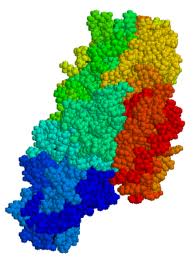Tissue Transglutaminase

Product description:Tissue transglutaminase (abbreviated as TG2 or tTG) is an enzyme of the transglutaminase family. Like other transglutaminases, it crosslinks proteins between an ε-amino group of a lysine residue and a γ-carboxamide group of glutamine residue, creating an inter- or intramolecular bond that is highly resistant to proteolysis (protein degradation). It is particularly notable for being the autoantigen in coeliac disease, but is also known to play a role in apoptosis, cellular differentiation, and matrix stabilisation.
Application:tTG is expressed ubiquitously. It requires calcium as a cofactor for transamidation activity. Transcription is increased by retinoic acid. Among its many supposed functions, it appears to play a role in wound healing, apoptosis, and extracellular matrix development.
TG2 also has GTPase activity: In the presence of GTP, it suggested to function as a G protein participating in signaling processes.Besides its transglutaminase activity, TG2 is proposed to also act as kinase,and protein disulfide isomerase,[4] and deamidase.This latter activity is important in the deamidation of gliadin peptides, thus playing important role in the pathology of coeliac disease.
Recent studies suggest that tTG plays a role in inflammation, degenerative diseases, and tumor biology.
Disclaimer: the information on this website is from the internet for reference only. Please refer to the actual instructions attached to the product and the final interpretation is owned by the company.
 for: Product Quotation ( Product suppliers),COA (Certificate of Analysis), New Sales
for: Product Quotation ( Product suppliers),COA (Certificate of Analysis), New Sales
Promotion,New Products,And any other assistance.
 After send online enquiry, we will reply you as soon as possible, if not get any response on time please contact us by Tel or Email.
After send online enquiry, we will reply you as soon as possible, if not get any response on time please contact us by Tel or Email.
1. Email: info@abpri.com
2. Tel: +86 592 5365887
3. WhatsApp: +86 189 6516 2351
4. Send enquiry online:


